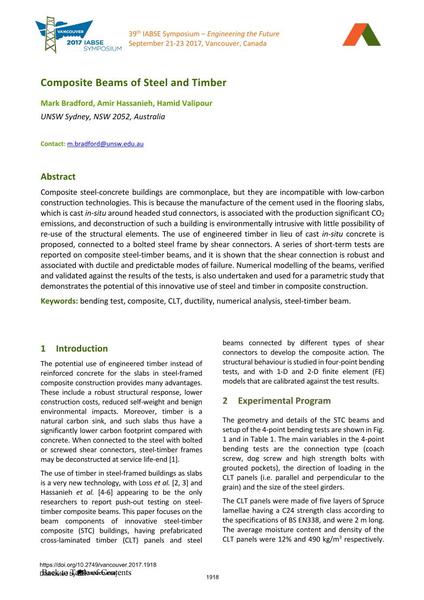Composite Beams of Steel and Timber

|
|
|||||||||||
Bibliographic Details
| Author(s): |
Mark Bradford
(UNSW Sydney, NSW 2052, Australia)
Amirhossein Hassanieh (UNSW Sydney, NSW 2052, Australia) Hamid Valipour (UNSW Sydney, NSW 2052, Australia) |
||||
|---|---|---|---|---|---|
| Medium: | conference paper | ||||
| Language(s): | English | ||||
| Conference: | IABSE Symposium: Engineering the Future, Vancouver, Canada, 21-23 September 2017 | ||||
| Published in: | IABSE Symposium Vancouver 2017 | ||||
|
|||||
| Page(s): | 1918-1925 | ||||
| Total no. of pages: | 8 | ||||
| Year: | 2017 | ||||
| DOI: | 10.2749/vancouver.2017.1918 | ||||
| Abstract: |
Composite steel-concrete buildings are commonplace, but they are incompatible with low-carbon construction technologies. This is because the manufacture of the cement used in the flooring slabs, which is castin-situaround headed stud connectors, is associated with the production significant CO₂ emissions, and deconstruction of such a building is environmentally intrusive with little possibility of re-use of the structural elements. The use of engineered timber in lieu of castin-situconcrete is proposed, connected to a bolted steel frame by shear connectors. A series of short-term tests are reported on composite steel-timber beams, and it is shown that the shear connection is robust and associated with ductile and predictable modes of failure. Numerical modelling of the beams, verified and validated against the results of the tests, is also undertaken and used for a parametric study that demonstrates the potential of this innovative use of steel and timber in composite construction. |
||||
| Keywords: |
ductility composite numerical analysis bending test CLT steel-timber beam
|
||||
